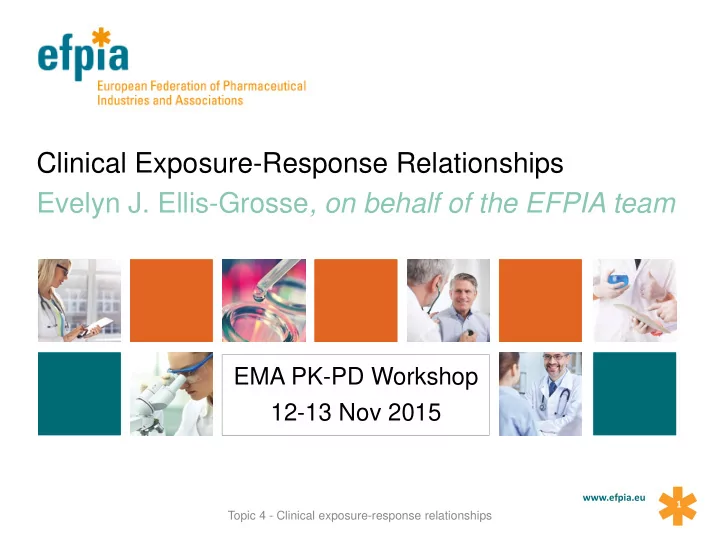

Clinical Exposure-Response Relationships Evelyn J. Ellis-Grosse , on behalf of the EFPIA team EMA PK-PD Workshop 12-13 Nov 2015 www.efpia.eu 1 Topic 4 - Clinical exposure-response relationships
Clinical E-R in Development Process (Section 4.5) • E-R provides an important step in the overarching pharmacometrics package within drug development • Utilized for a priori analyses and data exploration • Aims to quantify key effects against an exposure range • E-R is grounded by individual drug or drug class pharmacologic/toxicologic properties • Safety analyses (important, but not discussed in Guideline) • Efficacy analyses www.efpia.eu 2 Topic 4 - Clinical exposure-response relationships
4.5.1 Potential Value of E-R relationships (Slide 1 of 4) • “…used to describe interplay of MIC, PK and outcome…identify clinical PK-PD indices and clinical PDTs to support adequacy of dose regimens selected from nonclinical PK-PD indices and PDTs.” (Lines 468-472) • EFPIA recommendation: It may, at times, be possible to reduce programmatic requirements • Example, Sponsors with a known class agents having contemporary nonclinical data (PDT and MIC distributions), and confident knowledge of population variance (from small patient Phase 1 or adequate inflated variance in PK models) may facilitate sufficient data to proceed into Phase 3 • Suggested language: “Depending on prior class knowledge, nonclinical PDTs may sufficiently define target to reduce traditional programmatic requirements (e.g. dose finding, Phase 2)” www.efpia.eu 3 Topic 4 - Clinical exposure-response relationships
4.5.1 Potential Value of E-R relationships (Slide 2 of 4) “…it may not be feasible to describe the E-R relationship for all…. “(Lines 473-474) • We agree that there are well-delineated limitations in some settings: • Limited number of clinical patients • Small numbers of failures prevent robust analyses • Failures by MIC may actually follow population MIC distribution if dosing is generally adequate • Patient Confounders • Non-surgical interventions or adjunctive treatments • Underlying host factors/ patient severity • Immune function • High mortality ‘noise’ in some disease states www.efpia.eu • Death is always a failure of the antibiotic, attributable or not 4 Topic 4 - Clinical exposure-response relationships
4.5.1 Potential Value of E-R relationships (Slide 3 of 4) … limitations, continued: • Microbiologic challenges • Inability to obtain and/or identify organisms in all disease states • Debate regarding causative organisms in mixed infections • Which pathogen or MIC is selected for ER? Select the pathogen with the highest MIC? Or most commonly associated pathogen? • EFPIA recommendation: • We agree with and support retention of the language noting the limitations of E-R analyses. • Although such analyses should be attempted by Sponsors, it may not be possible to derive clinical PDTs in all settings, supporting reliance on nonclinical targets. www.efpia.eu 5 Topic 4 - Clinical exposure-response relationships
4.5.1 Potential Value of E-R relationships (Slide 4 of 4) Already licensed agents (Lines 486-493): • “….unlikely ER relationships can be used to support changes to dose regimens unless new efficacy studies are conducted … consider offering stored samples to interested parties.” • EFPIA recommendation: This section is unclear as it relates to E-R analyses. Please expand and clarify intentions www.efpia.eu 6 Topic 4 - Clinical exposure-response relationships
4.5.2 Analyses of E-R relationships • “…E-R relationships are confined to patients with documented outcomes, adequate PK and …MICs of the test agent…” (Lines 495-497) • Typical assessments (dichotomous): • Micro/clinical responses at TOC • Improvement in biomarkers (continuous, time-to-event) • PaO 2 /FiO 2 ratios, defervescence, decrease in wound size • EFPIA recommendation: • We appreciate the flexibility in model and statistical approaches based upon Sponsor’s data exploration. • Consider this additional language: “Sponsors are encouraged to explore alternative endpoints in E-R analyses to support dose justification and effect size estimations.” www.efpia.eu 7 Topic 4 - Clinical exposure-response relationships
4.5.3 Application of E-R relationships (Slide 1 of 2) • “ The ER relationship can be used to identify the highest MIC of the test agent that can be treated with confidence using a selected dose regimen, further supporting the initial predictions…” (Lines 510-512) • EFPIA Response: Appreciates EMA consideration in that E-R supports predicted PTA, but it may not fully reflect successful response rates due to multitude of potential confounding factors. • While ER analyses may be supportive to breakpoint analyses, PTA ≠ response rate • Difficult to accrue meaningful number of isolates at high MICs • Confusing results- - e,g, 3 at a highest MIC: 1 cure, 1 failure and 1 indeterminate Discussed further in Topic 6 • www.efpia.eu 8 Topic 4 - Clinical exposure-response relationships
4.5.3 Application of E-R relationships (Slide 2 of 2) • EFPIA recommendation: Suggest EMA consider additional application for E-R analyses, when achievable • E-R may be of assistance for difficult indications (e.g., nosocomial pneumonia) or those in which NI margins are not well defined (e.g., bloodstream infections, osteomyelitis, diabetic foot infections, etc…) • Consider this additional language particularly for indications where knowledge base is less: “Sponsors are encouraged to consider E-R analyses, and other pharmacometric-based analyses, for estimation of treatment effect sizes and hence, as a support in selection of non-inferiority margins (see also Section 4.7).” www.efpia.eu 9 Topic 4 - Clinical exposure-response relationships
Conclusions • E-R analyses provide an important step toward a comprehensive pharmacometric data package • E-R analyses should be encouraged for alternative applications ( e.g. exploring alternative endpoints, support of treatment effect sizes, etc..) • The noted limitations in deriving an E-R relationship in all settings, as well as the flexibility for Sponsor approaches to E-R analyses is appreciated www.efpia.eu 10 Topic 4 - Clinical exposure-response relationships
Thank you! EFPIA Brussels Office Leopold Plaza Building * Rue du Trône 108 B-1050 Brussels * Belgium Tel: + 32 (0)2 626 25 55 www.efpia.eu * info@efpia.eu www.efpia.eu 11 Topic 4 - Clinical exposure-response relationships
Recommend
More recommend